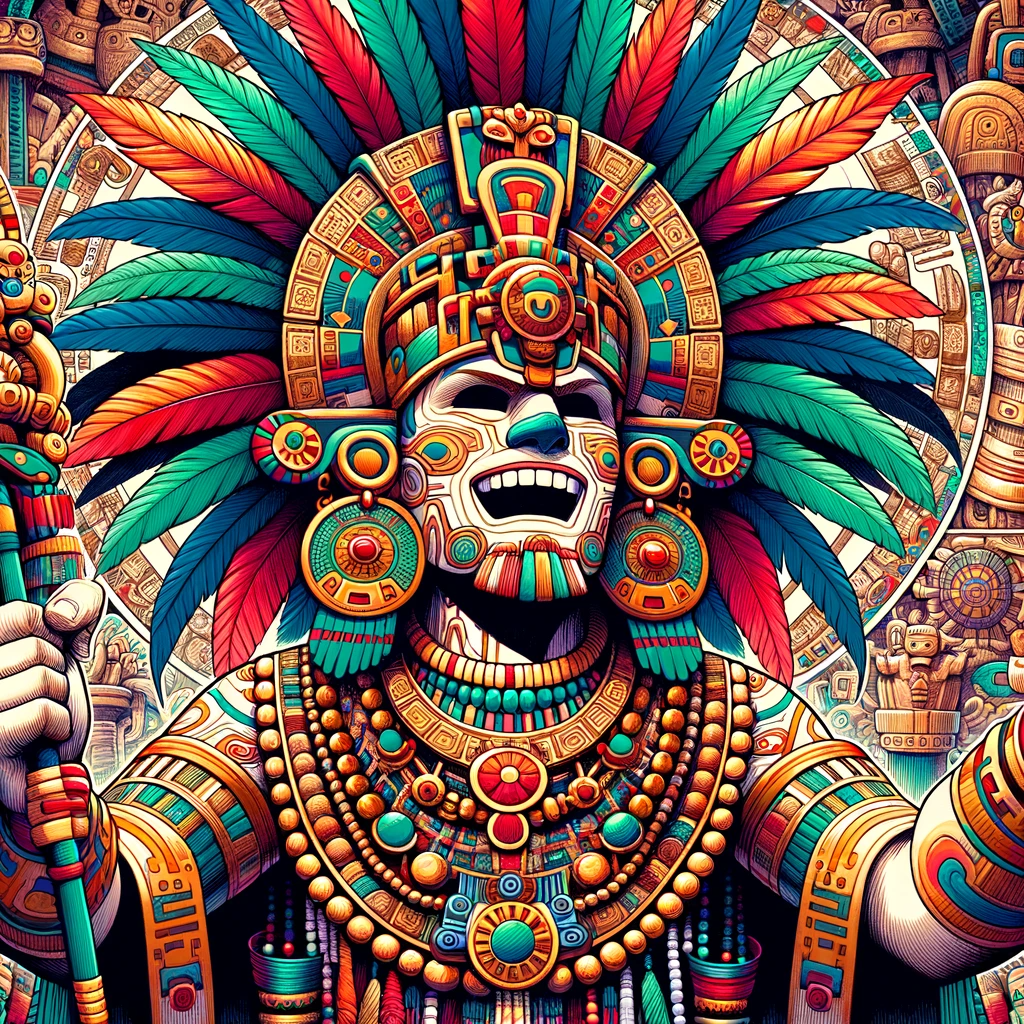
In the rich tapestry of Aztec mythology, where gods and goddesses represented forces of nature, aspects of daily life, and cosmic principles, Omacatl stands out as a deity associated with feasts, revelry, and merriment. This lesser-known but significant figure in the Aztec pantheon embodies the spirit of celebration and communal joy, offering a unique insight into the cultural and religious life of the Aztec civilization.
Origins and Name
The name "Omacatl" in Nahuatl, the language of the Aztecs, translates to "two reeds," symbolizing duality and balance, a recurring theme in Aztec mythology. This name suggests a connection to the Aztec calendar, where the day "Two Reed" was significant. Omacatl's origins are shrouded in mystery, and unlike major gods such as Quetzalcoatl or Tezcatlipoca, Omacatl does not feature prominently in Aztec creation myths or epic narratives. However, his presence in rituals and festivals underscores his importance in daily Aztec life.
Role and Significance
Omacatl's primary association was with feasts, banquets, and celebrations. He was invoked during festivities, especially those involving communal eating and drinking. These events were not mere social gatherings but held deep religious significance, serving as a means to strengthen community bonds, honor the gods, and ensure cosmic harmony.
One of Omacatl's key roles was to preside over the flow of food and drink, ensuring abundance and joy. He was seen as a facilitator of communication and fellowship, breaking down barriers between people. In a society where social hierarchy and order were deeply ingrained, Omacatl's festivals provided a temporary space where normal rules were relaxed, and people could interact more freely.
Symbolism and Representation
In Aztec art and iconography, Omacatl is not as frequently depicted as the major deities. However, when he does appear, he is often shown in a festive context, sometimes holding items associated with feasting, such as jars or plates of food. His imagery might include elements of merriment and abundance, like flowing drinks or bountiful harvests.
Rituals and Festivals
Omacatl's festivals were marked by elaborate preparations. Foods, particularly maize-based dishes and tamales, were central to these celebrations. Pulque, an alcoholic beverage made from the fermented sap of the agave plant, was also consumed. These festivals were not only about physical nourishment but also carried spiritual significance, with prayers and offerings made to Omacatl and other deities.
Cultural Impact
Omacatl's influence extended beyond religious rituals into the social fabric of Aztec life. His festivals reinforced community cohesion and allowed for the expression of joy and gratitude. They were also occasions for the community to come together, share resources, and reaffirm social bonds.
Conclusion
Although not as widely known as other Aztec gods, Omacatl played a vital role in the religious and social life of the Aztec people. His association with feasts and celebrations highlights the importance of communal joy and fellowship in Aztec culture. Omacatl's legacy offers a window into the everyday lives of the Aztecs, reminding us of the universal human need for celebration and community.
Origins and Name
The name "Omacatl" in Nahuatl, the language of the Aztecs, translates to "two reeds," symbolizing duality and balance, a recurring theme in Aztec mythology. This name suggests a connection to the Aztec calendar, where the day "Two Reed" was significant. Omacatl's origins are shrouded in mystery, and unlike major gods such as Quetzalcoatl or Tezcatlipoca, Omacatl does not feature prominently in Aztec creation myths or epic narratives. However, his presence in rituals and festivals underscores his importance in daily Aztec life.
Role and Significance
Omacatl's primary association was with feasts, banquets, and celebrations. He was invoked during festivities, especially those involving communal eating and drinking. These events were not mere social gatherings but held deep religious significance, serving as a means to strengthen community bonds, honor the gods, and ensure cosmic harmony.
One of Omacatl's key roles was to preside over the flow of food and drink, ensuring abundance and joy. He was seen as a facilitator of communication and fellowship, breaking down barriers between people. In a society where social hierarchy and order were deeply ingrained, Omacatl's festivals provided a temporary space where normal rules were relaxed, and people could interact more freely.
Symbolism and Representation
In Aztec art and iconography, Omacatl is not as frequently depicted as the major deities. However, when he does appear, he is often shown in a festive context, sometimes holding items associated with feasting, such as jars or plates of food. His imagery might include elements of merriment and abundance, like flowing drinks or bountiful harvests.
Rituals and Festivals
Omacatl's festivals were marked by elaborate preparations. Foods, particularly maize-based dishes and tamales, were central to these celebrations. Pulque, an alcoholic beverage made from the fermented sap of the agave plant, was also consumed. These festivals were not only about physical nourishment but also carried spiritual significance, with prayers and offerings made to Omacatl and other deities.
Cultural Impact
Omacatl's influence extended beyond religious rituals into the social fabric of Aztec life. His festivals reinforced community cohesion and allowed for the expression of joy and gratitude. They were also occasions for the community to come together, share resources, and reaffirm social bonds.
Conclusion
Although not as widely known as other Aztec gods, Omacatl played a vital role in the religious and social life of the Aztec people. His association with feasts and celebrations highlights the importance of communal joy and fellowship in Aztec culture. Omacatl's legacy offers a window into the everyday lives of the Aztecs, reminding us of the universal human need for celebration and community.